In today’s fast-paced digital world, businesses are always looking for new ways to connect with customers, streamline operations, and save money. Enter chatbots – those clever AI programs that chat with us online.
Once a novelty, these digital assistants are now becoming an essential part of how companies work and how we, as customers, get help and information.
If you’re curious about how chatbots are changing the game, what they can do for your business, and what the future holds, you’re in the right place.
We’ll dive deep into the latest chatbot statistics for 2025, showing you just how powerful and widespread these tools have become.
We’ll explore their impact on everything from customer support to sales, and even peek into what people are buzzing about on platforms like Quora and Reddit. Get ready to discover how chatbots can benefit you!
The Chatbot Boom: Market Growth and Widespread Use
The chatbot market is not just growing; it’s exploding! By 2025, experts expect the market to reach a massive
29.5 billion by 2029, showing a consistent annual growth rate of 24.8% and a Compound Annual Growth Rate (CAGR) of 30.0% between 2024 and 2029.
Why this incredible growth? Businesses are realizing the immense value chatbots bring. They can handle a huge volume of inquiries, work 24/7, and offer instant responses, which customers absolutely love.
Think about it: no more waiting on hold! This efficiency translates into significant savings. Companies are projected to save a staggering 2.5 billion working hours by using chatbots. Imagine what employees can achieve with that extra time!
Here’s a quick look at the market’s impressive journey:
Chatbot Market Revenue & Size
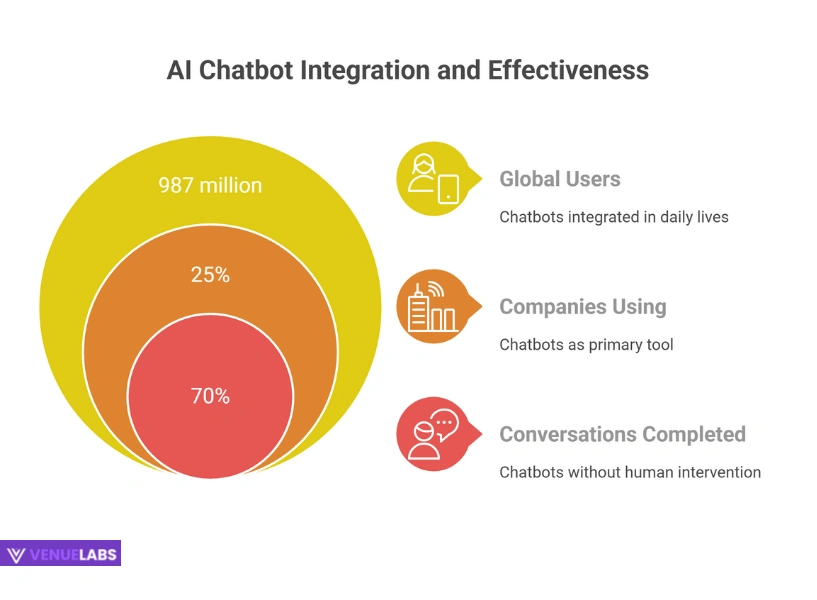
| Year | Market Value (Billions USD) | Projected Annual Growth Rate |
| 2022 | $5.1 | – |
| 2023 | $6.3 | – |
| 2024 | $8.27 | – |
| 2025 (Projected) | $10.32 | 24.8% |
| 2028 (AI Chatbots) | $72.6 | 51% CAGR (2021-2028) |
| 2029 (Projected) | $29.5 | 30.0% CAGR (2024-2029) |
| 2030 (Projected) | $27.3 | 23.3% CAGR (2022-2030) |
Already, over 987 million people around the globe use AI chatbots. This number clearly shows how integrated chatbots have become into our daily digital lives.
By 2027, a remarkable 25% of all companies will consider chatbots their primary tool for customer interactions. These smart programs are already capable of completing 70% of conversations without needing human intervention, proving their effectiveness.
Also read about: ChatGPT Statistics
The Power Players: Most Popular AI Chatbots
When we talk about AI chatbots, some names immediately come to mind. These platforms lead the pack, attracting millions of users with their advanced capabilities.
| AI Chatbot | Total Active Users (Millions) |
| Meta AI | 500 |
| ChatGPT | 300 |
| Google Gemini | 275 (Approx.) |
| Microsoft Copilot (Bing Chat) | 100 |
| Claude | 20 |
| Perplexity | 15 |
| Pi | 6 |
| Poe | 4 |
| Grok | 1.3 |
| HuggingChat | 1.2 |
Source: StatCounter
ChatGPT, in particular, has taken the world by storm since its late 2022 launch. It boasts over 300 million monthly active users and reached 1 million users in less than a week.
More than 92% of Fortune 500 companies now leverage ChatGPT, and its website averages over 1 billion visits every month. Google Gemini (formerly Bard) is a strong competitor, showcasing robust features and a significant user base with an average of 330.9 million monthly visits.
What’s driving this growth and adoption?
Several key trends are at play:
- Better Personalization: Chatbots are getting smarter at understanding individual customer needs.
- Industry-Specific Solutions: Customized chatbots for healthcare, finance, retail, and more.
- Seamless Business Integration: Chatbots easily connect with existing business systems.
- HR and Recruitment Applications: Assisting with employee questions and hiring processes.
- Stronger Security: Enhanced protection for sensitive customer data.
- AI and Machine Learning Advancements: Making chatbots more intelligent and conversational.
- Voice-Based Chatbots: Interacting through spoken commands.
- Omnichannel Support: Providing consistent help across various platforms (website, social media, apps).
- Ethical AI Practices: Ensuring fair and unbiased chatbot interactions.
- Integration with Virtual Assistants: Working seamlessly with tools like Alexa and Google Assistant.
Also read about: DeepSeek AI Statistics
Chatbots in Action: Where They Make the Biggest Impact
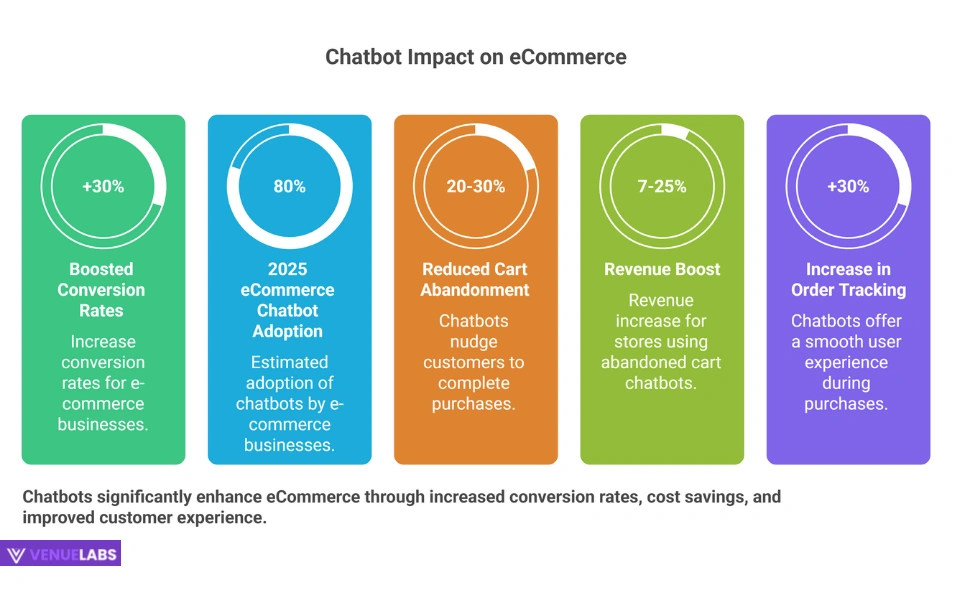
Chatbots are versatile tools, but they truly shine in a few key areas, transforming how businesses operate and interact with their audience.
Revolutionizing eCommerce
For online stores, chatbots are a game-changer. They help businesses improve sales, reduce costs, and enhance the customer experience.
- Boosted Conversion Rates: Chatbots can increase conversion rates for e-commerce businesses by up to 30%.
- Cost Savings: An average chatbot interaction costs just
- 6.00. These savings totaled $11 billion in 2022.
- Wider Adoption: By 2025, an estimated 80% of e-commerce businesses will use chatbots.
- Reduced Cart Abandonment: Chatbots cut down cart abandonment by 20-30% by nudging customers to complete purchases.
- Revenue Boost: E-commerce stores using Facebook Messenger and abandoned cart chatbots saw a revenue increase of 7-25%.
- Seamless Experience: Chatbots contribute to a 30% increase in order tracking and offer a smooth user experience during purchases.
- Future Sales Powerhouse: Chatbots are expected to generate $112 billion in retail sales.
Enhancing Customer Support
This is perhaps the most well-known application of chatbots, and for good reason. They provide instant, 24/7 support, significantly improving customer satisfaction.
- Personalized Support: 64% of businesses trust chatbots to deliver personalized customer support.
- Customer Preference: 34% of customers prefer communicating with a chatbot over phone or live interaction. In fact, 62% of consumers would rather use a chatbot than wait for a human agent.
- High Satisfaction: Chatbots achieve an 80% consumer satisfaction rate due to their accurate responses. Customer satisfaction for live chat (which often includes chatbots) is 85%.
- 24/7 Availability: Chatbots offer round-the-clock support, regardless of time zones.
- Efficiency: Businesses save up to 30% on customer support costs by implementing chatbots.
- Query Resolution: Chatbots can solve more than 75% of users’ queries, and 90% of complaints are instantly tackled when explained properly.
- Indifference to Human vs. AI: Interestingly, 48% of customers don’t care if their support is from a human or an AI, as long as their issue is resolved without delay.
- Industry-Specific Savings: The insurance sector alone is projected to save $1.3 billion in upcoming years by using chatbots for customer support.
Source: Statista
Boosting Business Efficiency and Sales
Beyond customer service, chatbots play a crucial role in internal operations and sales generation.
- Time Savings: As mentioned, chatbots save businesses 2.5 billion hours. This includes an estimated $8 billion saved by reducing chat support costs in retail.
- Increased Sales: 55% of businesses report more sales when they use chatbots.
- Customer Preference for Bots: Only 9% of users want chatbots eliminated, with the majority preferring them. 33% of customers even prefer chatbots over phone calls for reservations.
- Widespread Adoption: 80% of organizations are actively looking for ways to integrate chatbots into their services.
- Employee Focus: 64% of employees report that chatbots allow them to concentrate on other aspects of their work.
- Millennial Influence: 67% of US Millennials are more likely to make a purchase if a business uses chatbots to improve user experience and suggest offers. 40% of millennials also talk to chatbots for deals and discounts.
Everyday Work and Beyond
Chatbots aren’t just for big businesses; they’re becoming common in daily tasks.
- Primary Uses: Chatbots are mainly used in sales (41%) and customer support (37%), with marketing (17%) being the third most common use.
- White-Collar Efficiency: 70% of white-collar employees use chatbots to complete daily tasks and projects efficiently.
- Global Reach: In 2022, 88% of customers had at least one conversation with a chatbot. Globally, 87% of users give positive feedback on chatbots.
- Healthcare Impact: The healthcare sector saw a 10% increase in efficiency after incorporating chatbots.
- Significant Investment: An investment of $4.5 billion was made for integrating chatbots across various sectors.
- Growth Trajectory: The chatbot industry is projected to hit
- 455 million globally by 2027.
- User Ambiguity: Interestingly, 27% of customers using customer support don’t even realize if they’re talking to a chatbot or a human agent.
AI’s Growing Role: The “Chatbot Analyst” and Executive Priorities
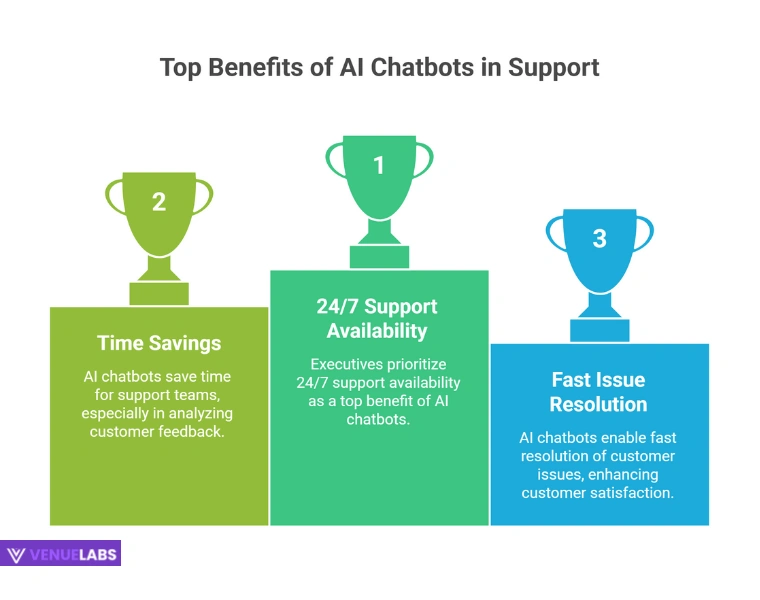
The rise of AI-powered chatbots is not just changing customer interactions; it’s creating new roles and priorities within companies.
- New Job Roles: 42% of support leaders believe a “chatbot analyst” position will become crucial for support teams in the coming years. Other potential roles include “conversational UX mapper” (32%) and “AI customer support specialist” (29%).
- Executive Focus: 30% of C-level support executives are making automated chatbot support a main priority for 2024. Overall, 70% of C-level support executives will invest in AI in 2024.
- AI Adoption: 45% of support teams are already using AI, with the majority resolving 11-30% of their support requests through AI.
- Benefits of AI: 50% of executives see 24/7 support availability as a top benefit of AI chatbots, followed by time savings (45%) and fast resolution of issues (44%).
- Time Savings for Feedback: 35% of support teams say AI helps them save time on analyzing customer feedback.
- Customer Preference for Speed: 61% of customers prefer the faster response times offered by AI chatbots over waiting for human agents.
The Human Element: Preferences, Annoyances, and Concerns
While chatbots offer incredible advantages, it’s also important to understand customer preferences, potential frustrations, and the broader societal impact.
What Customers Prefer:
We’ve seen that many customers prefer chatbots for quick tasks, but humans still have their place.
| Task | Chatbot Preference (%) | Human Preference (%) |
| Checking order status | 71 | 29 |
| Searching for products | 67 | 33 |
| Getting info about deals/discounts | 62 | 38 |
| Ordering food | 59 | 41 |
| Booking a meeting | 58 | 42 |
| Leaving contact details | 58 | 42 |
| Making a payment | 54 | 46 |
| Returning a product | 46 | 54 |
| Troubleshooting | 40 | 60 |
| Complaining about a product/service | 28 | 72 |
Customers expect chatbots to be available 24/7 (29%) and provide fast replies (24%). They also appreciate the ability to reach a human agent if needed (17%).
Challenges and Annoyances:
Not everything is smooth sailing with chatbots. Users still face frustrations:
- Understanding Context: 60% of consumers are concerned that chatbots cannot understand their queries, and 38.12% find it annoying when a chatbot is unable to understand context. This leads to repeating questions multiple times for 19.49% of customers.
- Preference for Live Support: 46% of people would rather receive live support, even if a chatbot was quicker.
- Data Security Concerns: 25% of customers have had personal information (like passwords or credit card numbers) mistakenly stored by a chatbot.
- Frustration: 53% of customers have reported feeling frustrated when interacting with a chatbot.
- Limited Resolution: Chatbots resolve 58% of returns and cancellations, but only 17% of billing disputes, indicating complex issues often still require human help.
Also read about: Perplexity AI Statistics
Impact on Jobs: A Mixed Bag
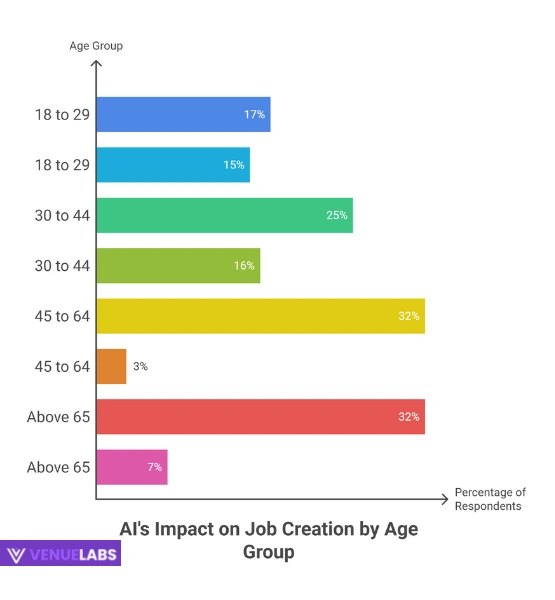
The rise of AI chatbots naturally brings up questions about their impact on the job market. While some tasks are being automated, new opportunities are also emerging.
| Age Group | AI Will Create More Jobs (%) | AI Will Lessen the Number of Jobs (%) |
| 18 to 29 | 17 | 15 |
| 30 to 44 | 25 | 16 |
| 45 to 64 | 3 | 23 |
| Above 65 | 3 | 27 |
U.S. citizens have varied opinions: 18% believe AI will lead to fewer jobs, while 25% of those aged 30-44 believe AI will create more jobs. Chatbots are freeing up human workers to focus on more strategic, empathetic, and complex tasks, while new roles like “chatbot developer” and “AI trainer” are being created.
Chatbots and Health-Related Queries: A Sensitive Area
Consumers are also turning to AI chatbots for health-related information, but with significant privacy concerns.
- Usage: Of those who use chatbots for health purposes, 8% look up medical term definitions, 7% ask health-related questions, and 7% look up symptoms.
- Privacy Concerns: A significant 45% of consumers believe AI chatbot companies should . Another 33% would allow storage as part of a user profile but not sharing with other companies. Only a small percentage are comfortable with data being used for training or shared with other organizations.
What Are Users Asking on Quora and Reddit?
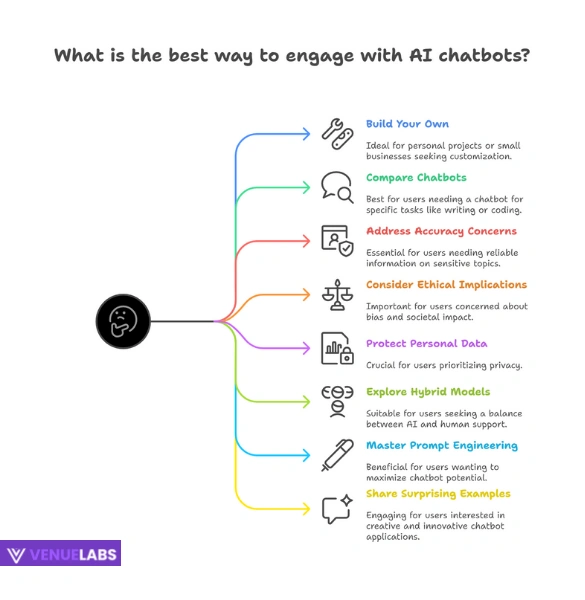
Beyond the statistics, looking at user-generated content on platforms like Quora and Reddit gives us a real-time pulse on current interests, frustrations, and desires related to chatbots. Here’s what people are actively discussing:
- “How do I create my own AI chatbot for free/cheap?” Many users are keen to build simple chatbots for personal projects, small businesses, or learning. They look for user-friendly platforms, coding tutorials, and advice on natural language processing (NLP). This indicates a growing desire for accessible AI tools.
- “Which AI chatbot is best for X purpose (writing, coding, research, creative tasks)?” Users often compare different chatbots (ChatGPT, Gemini, Claude, Perplexity, etc.) to find the best fit for specific needs, highlighting the specialization of these tools.
- “How accurate/reliable are AI chatbots for sensitive topics (health, legal advice)?” There’s a strong undercurrent of caution and skepticism regarding chatbots providing critical information, especially in areas where accuracy is paramount. Users share anecdotes of both helpful and misleading responses. This aligns with the survey data showing concerns about storing health data.
- “What are the ethical implications of AI chatbots?” Discussions often revolve around bias, misinformation, job displacement, and the “black box” nature of AI. Users are increasingly aware of the broader societal impact.
- “How do I prevent AI chatbots from collecting my personal data?” Privacy is a major concern. Users ask for tips on how to interact with chatbots without compromising their personal information, reflecting the statistic about personal data being mistakenly stored.
- “Will AI chatbots replace human customer service entirely?” This is a recurring debate, with users sharing experiences of both excellent and frustrating chatbot interactions, often concluding that a blend of AI and human support is ideal (hybrid model).
- “Tips for prompt engineering/getting the best responses from chatbots.” As chatbots become more sophisticated, users are actively trying to master the art of writing effective prompts to unlock their full potential.
- “What are the coolest/most surprising things you’ve seen an AI chatbot do?” Users love sharing impressive examples of chatbots generating creative content, solving complex problems, or even having philosophical discussions.
These discussions reveal a public that is both excited and cautious about chatbots, eager to learn, and highly sensitive to issues of privacy and accuracy. They also underscore the need for continuous improvement in chatbot design, particularly in understanding context and handling complex or sensitive queries.
FAQs About Chatbots Statistics
1. How significantly will the chatbot market grow by 2025?
The chatbot market is projected to reach an impressive $10.32 billion by 2025, continuing its rapid expansion towards an estimated $29.5 billion by 2029, reflecting a strong demand for automated communication solutions across various industries.
2. What are the main benefits businesses gain from using chatbots?
Businesses primarily benefit from chatbots through significant cost savings in customer support (up to 30%), increased operational efficiency by automating routine tasks, 24/7 customer availability, and improved customer satisfaction due to instant responses and personalized interactions.
3. Do customers prefer interacting with chatbots or human agents?
Customer preference is mixed; for simple tasks like checking order status or searching for products, a majority of customers (e.g., 71% for order status) prefer chatbots due to their speed. However, for complex issues, troubleshooting, or complaints, customers generally prefer human agents who can offer empathy and in-depth problem-solving.
4. What are some of the biggest challenges associated with chatbot usage?
Key challenges include chatbots’ inability to fully understand complex queries or context, which can lead to user frustration. Concerns about data privacy and the mistaken storage of personal information also pose significant hurdles that need to be addressed to build greater user trust.
5. How are AI chatbots impacting the job market?
AI chatbots are creating a dual impact on the job market; while they automate certain tasks previously handled by humans, potentially reducing roles in areas like basic customer service, they also create new job opportunities for “chatbot analysts,” “conversation designers,” and AI trainers who develop and manage these intelligent systems.
Also Read:
- Voice Search Statistics
- Microsoft Teams Statistics
- YouTube Statistics
- Google Chrome Statistics
- Android Statistics
Conclusion:
The journey of chatbots from basic automated responders to sophisticated AI companions has been nothing short of remarkable. The statistics for 2025 clearly paint a picture of a technology that is no longer optional but essential for businesses striving for efficiency, cost savings, and superior customer engagement.
With the chatbot market soaring towards 29.5 billion by 2029, their impact is undeniable. Over 987 million people are already interacting with AI chatbots, transforming how we shop, seek support, and even perform daily work tasks.
From boosting e-commerce conversions by 30% to saving businesses 2.5 billion working hours, chatbots are delivering tangible benefits.
However, the journey isn’t without its nuances. While customers appreciate the 24/7 availability and fast responses, concerns about a chatbot’s ability to understand context and protect personal data remain.
The discussions on platforms like Quora and Reddit further highlight these points, showing a discerning user base that values accuracy, privacy, and the option for human interaction when needed.
As AI and machine learning continue to evolve, we can expect chatbots to become even more intelligent, personalized, and seamlessly integrated into our lives.
Businesses that embrace this technology, while also addressing user concerns and focusing on a hybrid approach of AI and human touch, will undoubtedly lead the way in creating more efficient, responsive, and customer-centric operations. The future is conversational, and chatbots are leading the charge.
